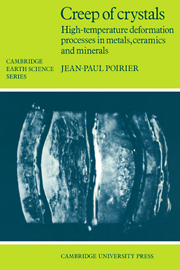Book contents
- Frontmatter
- Contents
- Preface
- 1 Mechanical background
- 2 The agents of deformation: lattice defects
- 3 Phenomenological and thermodynamical analysis of quasi-steady-state creep
- 4 Dislocation creep models
- 5 The effect of hydrostatic pressure on deformation
- 6 Creep polygonization and dynamic recrystallization
- 7 Diffusion creep, grain-boundary sliding and superplasticity
- 8 Transformation plasticity
- 9 Scaling and classification
- References
- Materials index
- Subject index
5 - The effect of hydrostatic pressure on deformation
Published online by Cambridge University Press: 06 October 2009
- Frontmatter
- Contents
- Preface
- 1 Mechanical background
- 2 The agents of deformation: lattice defects
- 3 Phenomenological and thermodynamical analysis of quasi-steady-state creep
- 4 Dislocation creep models
- 5 The effect of hydrostatic pressure on deformation
- 6 Creep polygonization and dynamic recrystallization
- 7 Diffusion creep, grain-boundary sliding and superplasticity
- 8 Transformation plasticity
- 9 Scaling and classification
- References
- Materials index
- Subject index
Summary
The effect of hydrostatic pressure on deformation is of secondary interest in materials science but it is very important in geophysics, as the hot silicate Earth's mantle extends down to depths where the hydrostatic pressure reaches values higher than 1 Mbar. The structure and composition of the Earth are summarily presented according to the latest models, and it is shown that the possibility of creep, hence convection in the lower mantle, is directly linked to the variation of the activation volume with pressure.
The effect of pressure on mechanical properties, either diffusion-or glide-controlled, is shown, in most cases, to be a manifestation of the anharmonicity of the crystals. It can be expressed in terms of the variation of the elastic constants with pressure. The effect is small in the case of athermal processes but may be large for the thermally activated processes, for which the energy barrier can be elastically modelled. Another indirect effect has its source in the dependence on pressure of the diffusivity of impurities (such as water-related species in quartz).
Elastic models for the activation volume of creep are reviewed and applied to the Earth's lower mantle.
Generalities: high-pressure deformation and geodynamics
The effect of hydrostatic pressure P on the flow stress or creep-rate of non-porous materials is much less important than the effect of temperature: indeed, for values of P currently obtained in the laboratory (a few tens of kilobars), there is only a second-order difference between the creep-rate under pressure and at one atmosphere pressure.
- Type
- Chapter
- Information
- Creep of CrystalsHigh-Temperature Deformation Processes in Metals, Ceramics and Minerals, pp. 145 - 168Publisher: Cambridge University PressPrint publication year: 1985
- 1
- Cited by



